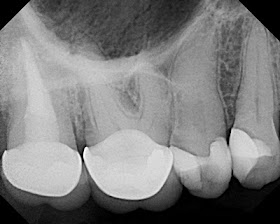Success with this treatment is dependent upon atraumatic extraction, minimal manipulation of the periodontal ligament, rapid replacement into the socket, and minimizing occlusal forces following replantation.
While endodontic apical surgery (apicoecotomy) is the most common type of endodontic surgery performed, intentional replantation is an option when apical surgery is not indicated due to anatomical considerations. These may include: proximity to the mental foramen or mandibular canal, thickness of Md buccal bone along oblique line angle, and proximity to Mx sinuses.
I have found intention replantation useful in the following clinical situations:
Cases where endodontic surgery is not an option due to difficult anatomy...
1. Md 2nd Molars - access through buccal bone difficult
2. Md 1st & 2nd Bicuspids - closeness to the mental foramen
3. Mx 2nd Molars - access difficult & sinus complications likely
Cases where conventional retreatment has been unsuccessful or not likely to be successful
1. Cases with ledging and/or separated instruments
2. Retreatment has been attempted without success
Other factors to consider...
The root anatomy has to allow an atraumatic extraction to occur. Conical shaped roots are most ideal.
Intentional replantation provides a treatment option when tooth replacement with an implant or bridge is not feasible.
These patients have already had endodontic therapy, and crowns placed. Costs associated with this additional treatment are minimal compared to cost of tooth replacement.
The following cases demonstrate intentional replantation.
CASE #1

RCT was completed and patient continued to have apical pain. Extrusion of sealer was assumed to be the cause of the apical periodontitis. Close proximity to the mental foramen makes apical surgery contraindicated.
 Following atraumatic extraction, the gross overextension of gutta percha is obvious. Apical resection and burnishing of gutta percha completed within minutes.
Following atraumatic extraction, the gross overextension of gutta percha is obvious. Apical resection and burnishing of gutta percha completed within minutes. Tooth replanted and treatment completed.
Tooth replanted and treatment completed.CASE #2
 Initial RCT completed.
Initial RCT completed. Sinus tract persists.
Sinus tract persists.
Non-surgical retx completed and symptoms persist. Discussion with patient of options:
1. Extraction
2. Replantation
Pt understood options and selected intentional replantation.
 Atraumatic extraction, immediate resection.
Atraumatic extraction, immediate resection. Replantation completed.
Replantation completed. 3 month recall. Tooth asymptomatic and completely functional.
3 month recall. Tooth asymptomatic and completely functional.Sources:
Pathways of Pulp, 9th edition - online version. p767-768.

You got a really useful blog I have been here reading for about an hour.
ReplyDeleteYes i will have to try this and see if it really works for me thanks for the information.
ReplyDelete